Curated OER
Cell Project
High schoolers investigate cells. They discover what cells are, where they are found, what they do and what they are made of. They construct a giant cell that is posted on the bulletin board.
Curated OER
Reel Projects
Students investigate projectile motion. In this projectile motion lesson, students investigate a website with an interactive lesson. Students view the changes in the projectile they see in the lesson. Students watch short video clips and...
Curated OER
"The Soil Around Us" Project
Young scholars look at Web sites containing information about soil and related subjects such as earthworms. They use Web site review sheets to focus their review of the content on the sites and to introduce evaluation concepts for the...
Floyd County Schools
Who Is Hibernating?
Young scientists explore the wintertime behavior of common animals with this presentation on hibernation. Offering clear explanations about the who, what, where, when, and why regarding hibernation, this resource is perfect for primary...
Curated OER
You Belong in the Zoo Project - Using HyperStudio
Learners explore the diversity of living organisms. They research an animal found in the zoo and plans a 10-card HyperStudio project about his/her organism.
Curated OER
Animal Adaptations to Various Environments
Fourth graders examine animal adaptatations for various animals and different environments throughout the year. They use the Internet to research these environments and apply them to the animals.
Curated OER
Researching and Writing in the Jungle
Students practice research and writing skills. They pick an animal to resarch from the template chioces and write a paragraph about the animal. In addition, a digital camera is used to insert student pictures onto the slides.
Curated OER
Barnyard Riddles - A Class Project
Learners choose and animal about which to research or compose a riddle. They organize and develop a slide show in which they create a background, import graphics, clip art, kid pix stamps, photos, and type their riddle.
Curated OER
Oceanography Research
Fifth graders locate information on a specific ocean animal using encyclopedias, nonfiction books, SIRS Discoverer, multimedia encyclopedias, and the Internet. They create an acrostic poem about the ocean animal they have been researching.
Curated OER
Kindergarten Takes a Trip to the Zoo
Students write, draw pictures and talk about their trip to a zoo identifying the animals that they saw. They create an iMovie that incorporates all of these elements.
Curated OER
Map-A-Buddy
Learners investigate the concept of tracking and spatial movements of animals in relation to the environment in which they live. They participate in an interactive activity by tracking one another over a pre-defined region, record the...
Curated OER
X-Ray Eyes
Learners observe Australian X-ray paintings for information and to understand the art techniques used. Then they imagine and draw the inner organs of an animal. Students also research the anatomy of the animal to analyze the accuracy of...
Curated OER
Lesson: After Nature: Dystopia and Detournement
Werner Herzog's film, Lessons of Darkness is the topic of this lesson on art, politics, and culture. Learners discuss the concepts of utopia, dystopia, detournment, and Scorched Earth then compose a paper which describes dystopian reality.
Curated OER
Rights and Responsibilities in History
Students research rights and responsibilities in historic themes using primary source documents. They produce an iMovie including appropriate images and sounds.
Curated OER
Marine Animals on the Move
Students work with partners to track tagged animals using real-time data from satellites. Students gather and analyze data, compile information and conclusions and then prepare a final presentation of their research.
Curated OER
WET Science Lesson #11: How Light Affects Water
Scientists listen to the story of Wadja Egnankou who works to save African mangrove forests. They experiment with refraction and the introduction of particulate matter to water. They conclude with creative writing about the need for a...
Curated OER
Creative Classroom Creatures
Students are introduced to the five kingdoms and discover why there is a need for a classification system. Using the internet, they examine how scientific names are created and practice putting animals into their correct classification....
Curated OER
Comparing Mitosis with Meiosis
Life science learners view an online animated mini textbook comparing two types of cell division. Working in groups, they use a digital microscope to capture images of cells in different stages of mitosis and meiosis. Then they create an...
Curated OER
You Smoke You Croak
Sixth graders investigate the effects of tobacco. In this personal health activity, 6th graders use print and Internet sources to research the effects of smoking. Students create PowerPoint presentations using their research findings.
Curated OER
Coding History
Students study the topic of codes in Computer Science. They research it history, divisions in the field and its applications. The lesson plan also includes a brief overview of the information technology theory.
Curated OER
What is a Tornado? How are Tornadoes Created? How are Tornadoes Measured?
Explore the concept of tornadoes with your class. They will research what to do during tornadoes and how to measure tornadoes. Multiple resources are included.
Curated OER
Can You Find a Solution?
Students explore the topic of public conservation. In this Florida panthers lesson, students read a scenario about the endangered panther and collaborate to plan a way to protect the panther population. Students also participate in a...
Curated OER
Endangered Species... It's Not Too Late
Students choose an endangered species to research and report on. In this endangered species lesson, students complete a worksheet to gather information about their endangered animal and then use to write a book about the animal and...
Curated OER
Let's Go Fact Fishing!
Students work in pairs to research animals in the ocean. They use the Internet, encyclopedias, and resource books to complete an information sheet with a photo of the animal and three facts. They present their mini-reports to the class.

























